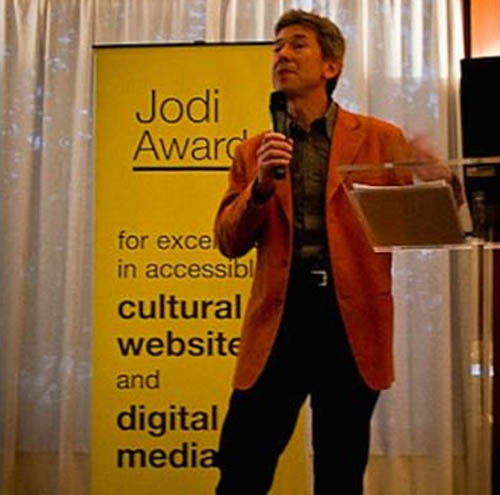by Marcus Weisen, September 2011
European campaign for web accessibility
This happy picture of open access is not so straightforward for many disabled people. In June 2011, The European Disability Forum, the European Blind Union and Euro Age Platform launched a campaign to ask for websites to be accessible by 2015. Their research found that only 5% of European websites are accessible (by which they meant that only this small proportion of websites meets Web Content Accessibility Guidelines (WCAG 1) Level AA – which public sector websites in the UK and in Europe have a duty to meet) (www.euroblind.org/news/nr/399).
The MLA Audit of 300 museum, library and archive websites found that the five most common accessibility problems encountered by users accounted for 44% of all problems uncovered by user testing (and the 13 most common ones accounted for 68% of them). Common problems include the absence of description on images (no ALT tags), poor contrast between content and background and too small text and graphics (www.jodimattestrust.org.uk/practice).
Dedicated attention to a limited number of accessibility problems can lead to real improvements in web accessibility.
Web accessibility: the unique contribution of cultural organisations
Museum, gallery and heritage sector websites will always be different to supermarket websites. They have a unique contribution to make to web accessibility. Increasingly, they are full of stories, informal learning materials, images, videos and online collections. These are seldom accessible to visually impaired people, people with dyslexia, people with a learning disability, people who are Deaf.
The features that are so often missing include: audio description, contrast, magnification; speak reader and text highligthing software; easy-read language, high quality visual and symbol communication, content produced with users; sub-titling and Sign Language.
Accessible culture making a difference
The Jodi Mattes Trust for accessible digital culture gives the annual Jodi Awards for the best use of technology by museums, galleries, libraries, archives and heritage sites to widen access to information, learning, collections and creativity. Projects by disability organisations which engage with collections are also eligible. Every year, we add practical and inspiring case-studies of Winning and Commended projects to our website to stimulate creativity and change (http://www.jodiawards.org.uk/awards-listing).
Visually impaired artist Sally Booth won the 2009 Jodi Award for Digital Access Online with her website. It presents different kinds of audio description, has good contrast and clear lay-out and provides information in British Sign Language. Moreover, it’s a beautiful website. Here, a pennyless artist (certainly not a rich one!) sets a standard that thousands of museums and arts organisations would do well to follow (http://www.sallybooth.co.uk/).
The shortlist of the 2011 Jodi Awards, drawn on 30 September, includes very innovative projects, such as:
Whitney Museum of American Art: in the Video Blog, Deaf museum educators communicate about contemporary art in American Sign Language. The goal of these vlogs is to increase cultural opportunities for Deaf and hard of hearing audiences and create a communications laboratory to expand the American Sign Language (ASL) vocabulary of contemporary art terms. These sub-titled, high definition, professionally presented and edited videos are now among the most popular ones for all the museum’s web audiences! And the museum now has the skills to subtitle all its videos with free sub-titling software (http://whitney.org/WatchAndListen/Tag?context=Access).
uScreen is a fully accessible website for young disabled filmmakers aged 14-25 for making, sharing and showing films. Young disabled people have led the ideas, fed into the technical development and have on-going input to its expansion. uScreen members can use specially created tools to create and edit films and to learn new skills, receive expert mentoring, meet new friends and make contacts with film-makers and specialists across the region (www.uscreen.co.uk).
More about digital technologies
Although their name suggests otherwise, inter-active touch screens are notoriously inaccessible to blind people.
Some visually impaired people find mainstream audio guides useful, but these would be so much more accessible with audio description – and some fully sighted people love it too.
Multi-media guides with Sign Language are on the rise. They should always have sub-titles, as free sub-titling software exists.
At the Cité des Sciences in Paris, Deaf actors feature in videos for all visitors and are very popular. The discovery centre leads on using visual communication, such as animation, to communicate to Deaf people and non-Deaf people of all ages. This is not accessible to blind people, but the museum is very strong on intellectual access for visually impaired people as well (http://www.mai-tagung.de/mai-tagung+2010/beitraege2010.htm, look under ‘Keynote: word document, page 13 and Power Point).
More case-studies can be found on: www.jodimattestrust.org.uk/awards
Well used, digital technologies can reduce existing cultural exclusion of disabled people and Deaf people. Each time accessibility and inclusion are not part of the design brief, cultural exclusion is being increased.
There is a real need for discussion around and guidance about an inclusive design concept and practical guidance about exploiting the power of technology to widen intellectual access to museum collections and art for disabled people. Jodi Mattes Trust, the University of York, Signes de Sens (www.signesdesens.org) and others are beginning to address the gap (www.mcn.edu/mcn-2011-program; starting 17 November 2011, six access sessions, in mustard colour boxes). But let’s not forget that web accessibility guidelines have been in existence for many years (www.w3.org/WAI/intro/wcag).
Creativity and rights
Access to culture is also a right of disabled people. The United Nations Convention on the Rigths of Persons with a Disability (ratified by the UK in 2009) recognises the right of disabled people to take part in cultural life ‘on equal terms’ (www.jodimattestrust.org.uk/policy).
Rights enhance human and organisational creativity. Many projects aimed at audiences with a disability have proven to stretch the creative imagination of museums, galleries and arts organisations. They often benefit all audiences.
No need to be fearful of cultural rights! Digital technology pushing boundaries is part of this agenda.
Marcus Weisen is the Director of the Jodi Mattes Trust for accessible digital culture.
